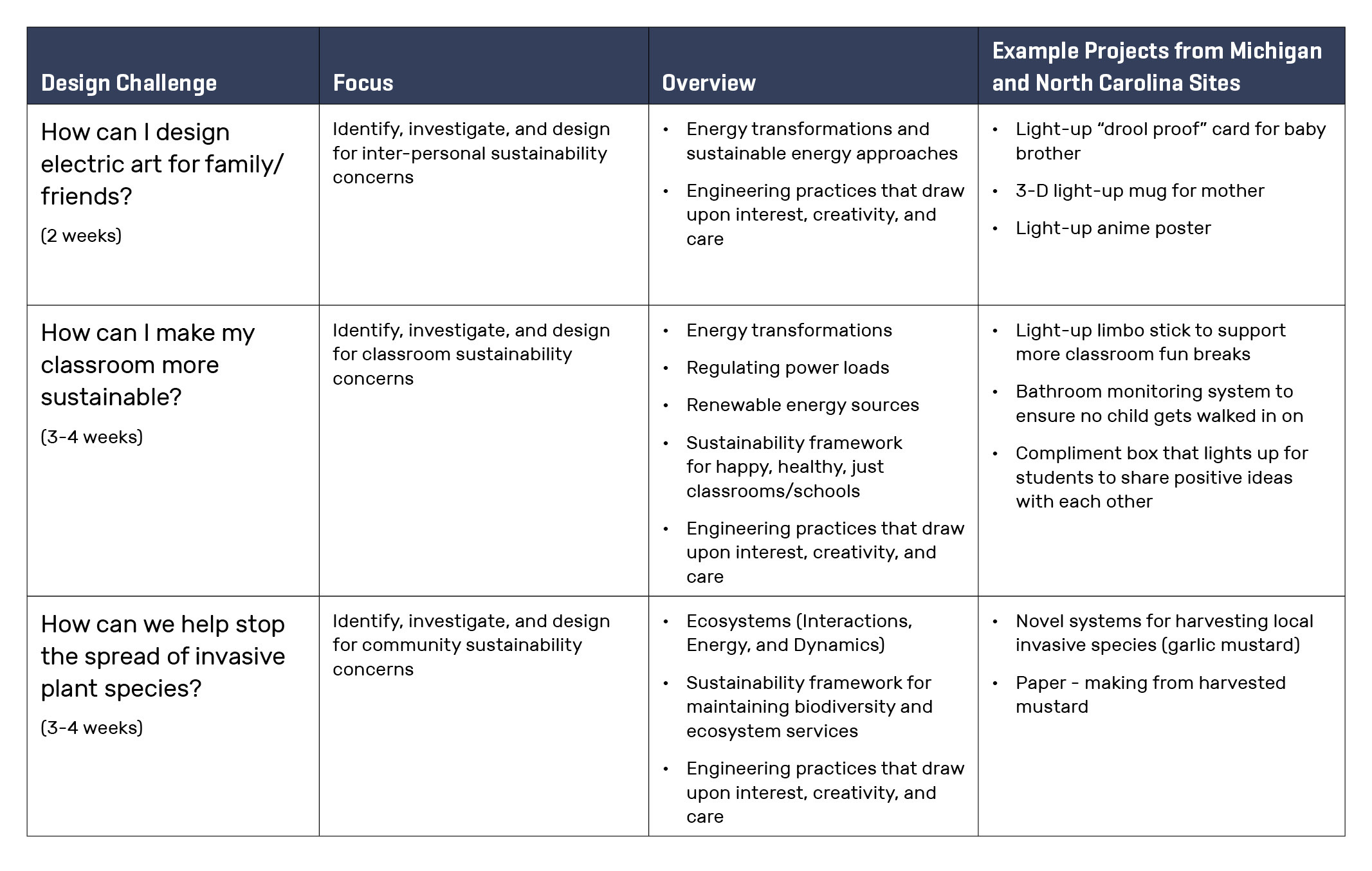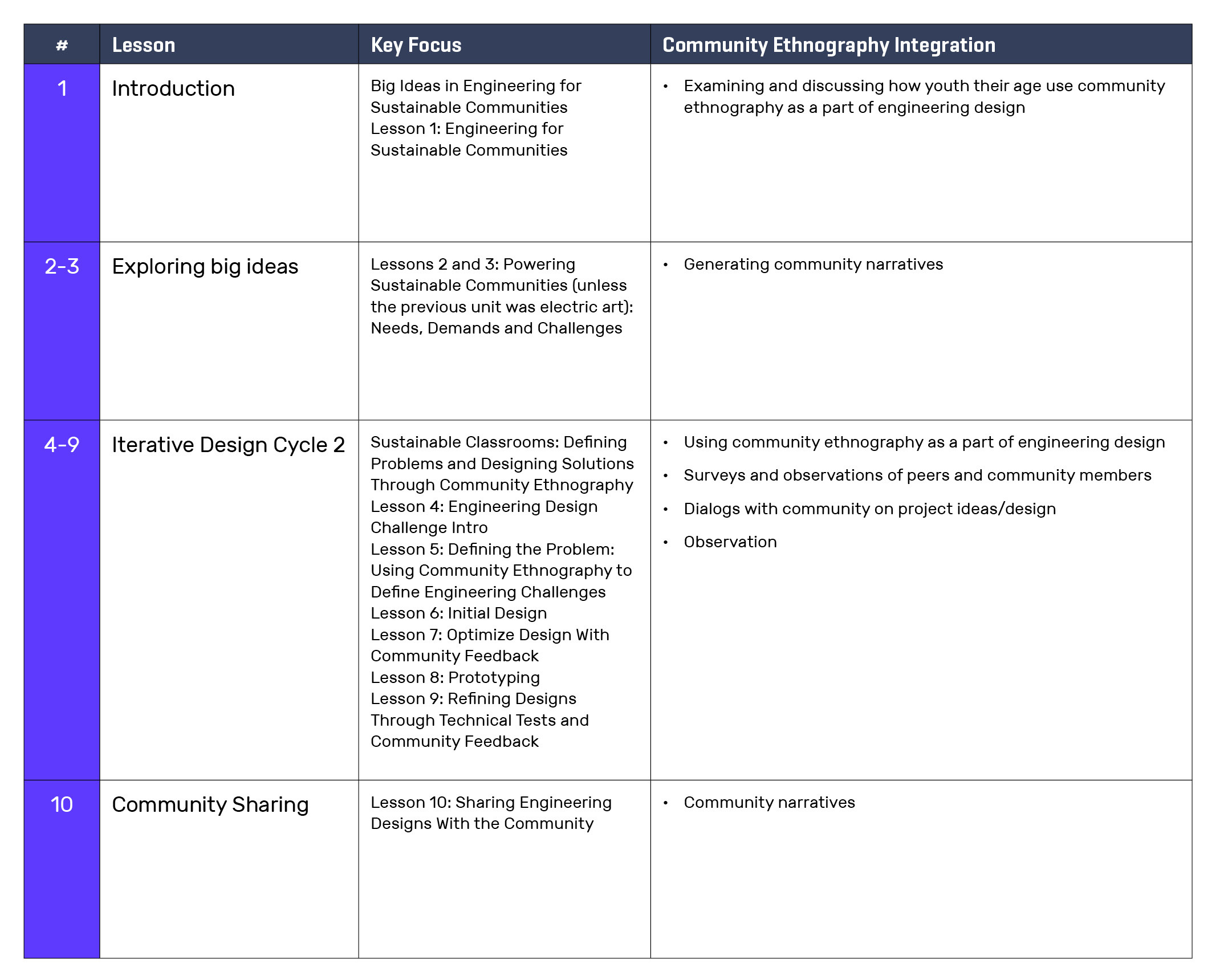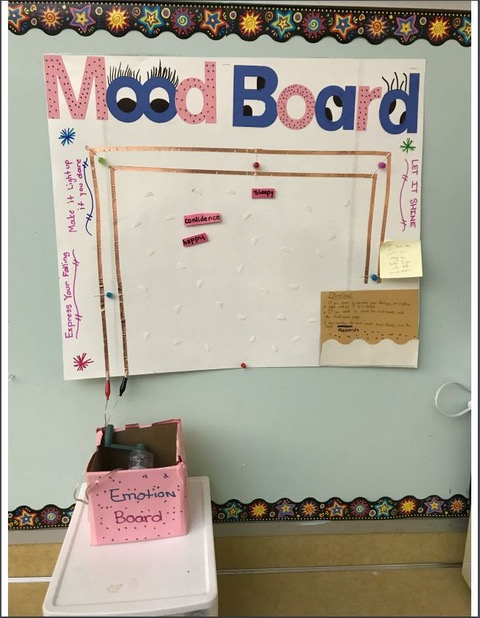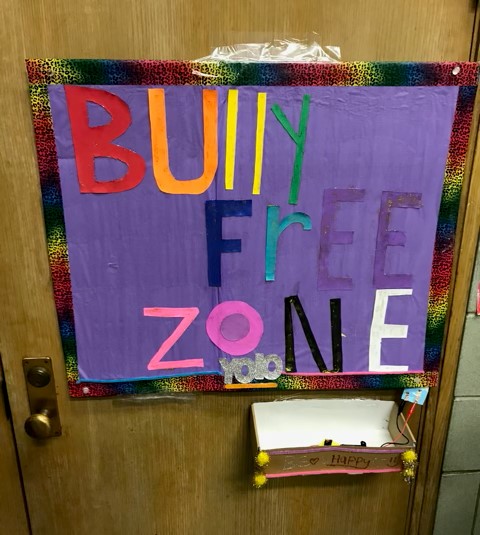Research to Practice, Practice to Research
Critical Consciousness in Engineering for Sustainable Communities
A Justice-Oriented Approach Connecting Schools and Communities
Connected Science Learning January–February 2022 (Volume 4, Issue 1)
By Geling Xu, Aerin Benavides, Angela Calabrese Barton, Edna Tan, Selena Bliesener, Gina DiFrancesco, and Scott Calabrese Barton

Critical consciousness is an important dimension of integrated science and engineering, or STEM, learning. Education is never neutral—it either supports students in conforming to the status quo, or it engages youth in a practice of liberation (Friere 1971/2000). Critical consciousness calls attention to how learning involves an awareness of understanding how inequality operates in society, including its structural roots, and the agency to engage in action toward social transformation. It is a powerful way to connect classrooms and communities toward the goals of justice-oriented STEM education (Upadhyay et al. 2021).
This article shows how an Engineering for Sustainable Communities (EfSC) approach to teaching engineering in the middle grades can support strong connections between classrooms and communities by fostering critical consciousness. We show how critical consciousness should not be viewed as separate from learning the content and practices of STEM, but rather as a way to orient how and why learning STEM matters in everyday life and hoped-for futures.
To accomplish this, we
- present the EfSC approach,
- draw on insights from student engineering design work to illustrate what critical consciousness looks like in STEM learning and its role in building connections between classrooms and communities, and
- offer implications for educators.
Our approach to supporting critical consciousness in teaching and learning STEM is grounded in a stance that engineering design requires people to integrate STEM ideas with social awareness. As students learn science and engineering knowledge and practice through class work, they need opportunities to improve their abilities to apply the learned knowledge in new contexts. Such contexts include the many problems that exist in the school community—students bullying each other, feeling school should be more fun, or needing more opportunities to celebrate achievements, which become important fodder for critical consciousness and problem-solving in STEM education.
Why Critical Consciousness in STEM Education?
Minoritized youth can face dehumanization and marginalization in schooling on a daily basis. These oppressions are heightened in STEM education through the underpinning norms, routines, discourses, and practices of whiteness and heteropatriarchy. Not only do these norms define what it means to know, do, and become in STEM, they also shape what and how classrooms and communities interact in STEM education.
Supporting critical consciousness as an explicit goal of STEM education is important because it fosters awareness, critique, and transformation of oppressions as they play out in classrooms and society. Critical consciousness can be thought about in terms of a praxis-informed cycle. It involves moving from awareness and critique or “critical awareness” to action-taking in ways that further inform awareness, allowing the cycle to continue. Critical awareness involves a process of learning to see, question, and analyze current social realities, including both social arrangements and structures, and how they limit opportunities, perpetuate injustices, and otherwise constrain people’s lives. One “has to see the world in its true dimensions and possibilities before attempting to generate change” (Cammarota 2016, p. 237). Action-taking involves developing the perceived capacity and commitment to engaging in action to address perceived injustices, as well as the actions themselves (Diemer et al. 2021). Critical action can be individual or collective and reflects how people understand oppressions and their imaginations for social change.
Engineering education—engaging in design, from problem posing to designing and prototyping solutions—is a powerful space to support critical consciousness. This is especially true when the problems taken up are authentic, and students have opportunities to design and build solutions for the real world. Furthermore, moving from critical awareness to action-taking supports students’ deepening technical knowledge and practice, and their understandings of current social realities (oppressions) and possibilities for social transformation. Studies show that supporting students in developing a critical consciousness simultaneously supports academic motivation and achievement, while promoting critical awareness (El-Amin et al. 2017).
Bridging Classrooms and Communities
Much of the design work in integrated science and engineering has focused on science and engineering practices, problem-solving, and exploring the value of integrating content areas for learning (Upadhyay et al. 2021). Despite the rich possibilities for connecting engineering design with communities, little work has been done supporting teachers in doing so with students. We are particularly concerned with how to design for supporting critical consciousness as a part of engineering design in ways that purposefully connect families and communities with engineering in authentic ways.
We, a team of engineers, teachers, and educational researchers, developed a framework to support middle school teachers and students in centering community and environmental considerations as they learn about and engage in the practices of EfSC (Calabrese Barton and Tan 2019; Tan et al. 2019). This approach takes into account social, political, cultural, and environmental concerns from community members toward a sustainable technological solution. The National Academies (2010) suggested that an important part of engineering education is to engage learners in understanding the importance of both the community and the environment in engineering design, and the engineer’s responsibility in the process. They refer to this approach as Engineering for Sustainable Community Development. We drew upon this framework to co-design and enact engineering units focused on sustainable communities and energy transformations. These units were implemented, reviewed, and revised with 18 sixth-grade teachers and hundreds of students in Michigan and North Carolina. All unit materials are available online.
Our Engineering for Sustainable Communities (EfSC) Framework has four main principles:
- Uses Community Members’ Ideas in Engineering. Working alongside community members to improve the daily lives of people they know, students learn about the importance of community input about the problems affecting them, and community suggestions for possible solutions. Throughout the engineering design process, students elicit multiple community perspectives about the problems they defined, their proposed solutions, and multiple design interactions/prototypes.
- Helps the Community Solve Problems Through Engineering. By helping the community solve problems, students learn and experience how all community members have the right and responsibility to contribute to defining problems and designing solutions. Community members are treated more justly, and collectively design solutions that work toward improving the community.
- Cares About the Environment. Caring about the environment involves designing solutions while minimizing impact to the environment. This can mean maximizing materials already available in classrooms and communities, using renewable resources (such as cardboard from delivered boxes), supporting renewable energy sources, and building projects that last.
- Designs Solutions for Now and in the Future. Balancing trade-offs equitably among environmental and social effects of designs is a design process that values increasing community members’ well-being and the development of involved people and communities. The involvement of relevant perspectives in both engineering and local communities (e.g., parents, teachers, engineering experts) and evaluating the degree of their impact in the design process, helps maintain the balance of perspective in this process.
By integrating technical and social dimensions of problems and solutions to the process of localizing engineering design, teachers support students in seeing themselves as welcome and able to use engineering to support their community. Furthermore, EfSC principles align with the call “to define problems more precisely, to conduct more thorough process of choosing the best solution, and to optimize the final design” (NGSS 2013) through recognizing the active role school and community members can play in engineering design.
EfSC supports movement of people, ideas, and resources across these different and connected communities as a part of the engineering design process. Students learn about how their classroom community is situated within a school community, which, in turn, is situated within their local community. Teachers help students navigate from a disciplinary core idea (e.g., energy transformations) to a problem space where they can define a problem worth solving and develop realistic and testable designs based upon current knowledge, empirically investigating technical and social dimensions, and operational constraints and specifications (e.g., What, powered by alternative energy, can I build to prevent bullying?). We want students to be able to say, “I can solve this problem collaboratively here in my community right now using what I know and what I have” rather than waiting to only use their STEM expertise in long-term future career goals.
Bringing EfSC to the Middle Grades Classroom: I-Engineering
We have developed and tested I-Engineering with the following tools and materials in collaboration with partnering teachers and schools (Table 1). Each challenge is guided by a driving question and moves students through three phases.

Click here to enlarge
Phase 1: Defining the Problem. This phase focuses on learning how to define an engineering problem, which requires thoughtful integration of engineering and community expertise. To support youth in more precisely understanding a design task’s boundaries—including its criteria and constraints from this integrated vantage point—we designed lessons to support students in seeking out, analyzing, and integrating both scientific and community knowledge to specify, expand, or limit movement toward possible solutions. This phase introduces students to the principles of EfSC.
Phase 2: Designing Solutions. Students are supported in systematically fleshing out their design solutions. Teachers engage students in community surveys as part of the design process to support students in generating and analyzing data from multiple perspectives in engineering design. Teachers then help students figure out how the social dimensions of the design interact with the technical elements. The design process focuses on:
- the ongoing refining of design constraints and evaluating possible solutions toward optimization;
- multiple cycles of designing/conducting tests toward optimizing solutions;
- gathering/analyzing data from multiple perspectives including peers, school personnel, and families; and
- engaging in dialog on complicated conflicts in perspective and design trade-offs.
A significant aspect of this design phase includes presenting design solutions—with rationales and data—to outside experts, including engineers, science educators and community members. Students are supported in breaking down the process through a sequential series of physical representations.
Phase 3: Prototyping and Optimizing Solutions From Multiple Perspectives. In this phase, youth build, test, and refine working prototypes as they communicate ongoing findings with school and community stakeholders to critically think through maximizing trade-offs. The lessons support youth in making visible the iterative nature of design work. Students are scaffolded in functionally decomposing, organizing, and trying out different computations informed by different perspectives/ feedback obtained.
In this manuscript we report on student work from our unit focused on “How can I make my classroom more sustainable?” (Table 2). As a part of the unit, students are given the design challenge bounded with the following criteria: Innovate something in the classroom in a way that would address a classroom and community sustainability problem. Students were required to use a renewable energy source (such as solar panels or hand crank generators), 10 mm LED lights, copper tape, and any materials available in and around their classroom and school.

Click here to enlarge
What Students Learned in the I-Engineering Unit
We share descriptions of two group projects from partner teachers’ classrooms to show how EfSC supported students in developing critical consciousness as a part of engineering learning, and how it powerfully connected schools and communities. We show that students’ critical consciousness in EfSC was built on three forms of critical awareness: community, technical-social iterative design, and sustainability. As we present these cases we show how:
- By engaging in community ethnography as a part of engineering design (e.g., surveys, interviews, and observations), students developed a critical awareness of community needs and wisdom.
- By engaging in engineering design of authentic community problems where both technical and social know-how mattered, students developed a critical awareness of how iterative design could be used to better their community in consequential ways.
- By supporting designs incorporating green energy sources and environmentally friendly considerations, students gained critical awareness of environmental sustainability.
Then, as students iteratively engaged in local, real-world engineering design challenges, they moved from critical awareness to taking action in ways that bridged their social and technical knowledge.
Case Study: Ms. L’s Class Mood Board
Students in Ms. L’s class in the Mood Board group (Figure 1) addressed the problem that students need a way to express their feelings. Ms. L asked the class how they might find out what problems members of their classroom and school community cared about. The class co-generated questions such as, “What challenges related to a happy and healthy community do you think are most important?” Students then surveyed and interviewed peers, school personnel, and families. After analyzing responses, students noted that the majority of respondents indicated a need for a stronger sense of community, along with the importance of helping people and fostering a happier classroom.

The group originally planned to make a light-up basketball hoop recycling bin, which they thought would bring fun into the classroom. However, as group members analyzed survey data and shared those insights with visiting community members and peers, they became aware that many students were struggling to feel welcome because they felt sad, angry, and frustrated due to being bullied, having friend difficulties, and getting in trouble. Sage described:
“Originally, we were going to make a recycling bin…. When Ms. S. [a student’s mom] came and sat with us and she started asking questions, and we were like, ‘Oh, we didn't think about that, we didn't think about that.’ So, we went to our second idea.”
Students’ emerging critical consciousness on the lack of opportunity to express a range of emotions that contributed to an unhappy/unhealthy classroom community was prompted by community survey findings.
The group parlayed their developing critical awareness of community into action when they decided to design a “mood board.” Sage stated this project was important because, “Students normally don't have a way to express their feelings and show how they feel. Normally you can only talk to someone or use your body language. Some people don't feel comfortable doing that. When someone's using the Mood Board, it’s easier for them to express their feelings.” Layla pointed out that she is sometimes sleepy in class because she stays up late to greet her mom coming home from her night shift. Her sleepiness causes her to feel cranky and get in trouble. The group explained:
“We created an invention to help solve this problem. Students can put their hand in the box and pick a mood that fits how they’re feeling. Then they put it on the board. If students want to light up the board, all they have to do is turn the hand crank.”
Students noted that people could use the light-up recyclable paper board with LED lights on a copper tape parallel circuit to draw attention to their posted feelings. They also explained that if a student sees someone share that they are feeling angry or sad, then “you can practice empathy and try to make them feel better in some way or show you understand” because their project helps call attention to people’s moods. In this way, the students pushed for the importance of recognizing and making visible a range of student feelings as important in school science. Students also handed out “mood board cards” to their peers, school personnel, and family members to encourage use of their design. Sage explained:
“I handed out those mood board cards to my parents. I gave one to Kali and Xander. They were like, “Oh, wow.” They were excited! They were like, ‘We could use something like this. Wow, I’m so impressed with you.’ My mom was like, ‘Oh, you’re so successful in your group. I wanna meet them!’”
Sage later said her mom wanted to come in to try out the mood board.
The group struggled to get their prototype to work the way they wanted and had to engage in many iterations, thus increasing their critical awareness of the intersections of technical engineering design with social design for community needs. They engaged in many cycles of testing the prototype: “First, we tested our lights to see if it worked. Another test we did is we tested if our moods [the mood options they offered] fit everyone.” They modified how their board was designed and used, as Kai explained, “We changed the design. Yeah, we changed the design, and the way we put our copper tape on the circuit, . . . we changed the moods, the feelings.” Sage further noted, they “wanted everyone in their class to put how they are feeling up on the board at the beginning of the day, and change it if they want to, as the day goes on.”
Case Study: Ms. P’s Class Bully Free Zone
Students in Ms. P’s class in the Bully Free Zone project (Figure 2) addressed the problem that school needs to be more fun, positive, and safe from bullying. Surveying members of their classroom and school community along with parents, they found that 25% of participants felt that school needed to feel safer. Using interviews with peers and personal experiences, they narrowed down the “need to feel safe” to a particular problem space—bullying. Group members wrote, “We chose to address this problem because students were bullying each other. Bullying created a lot of drama in the school, and this created students to feel really bad about themselves.”

Collecting and analyzing survey data helped the group develop critical awareness of classroom community needs. They learned how important safety was to their community. Going to the school’s restorative justice room for bullying was an insufficient solution in their minds. Lataya explained that:
“The restorative justice room was a waste of time. It didn't work and caused them to have to leave their classrooms. Students wanted to be able to stay in their own classrooms and have a space to be protected.” (Researcher Field Notes)
Critical awareness shifted to action taking when students put their understandings of community need into designing a possible solution. Using survey data, the group designed an area they called the Bully Free Zone. If a student felt bullied, they could go into this zone where teachers and peers would know they needed to feel safe, rather than needing to negotiate with the bully immediately in the restorative justice room. The group felt their innovation addressed bullying more directly because the Bully Free Zone would let students know that someone was there for them, without the need of finding and informing a teacher at the point when one is hurting from being bullied. Several parents and grandparents visited on “feedback cycle” day and offered supportive ideas and suggestions, such as having a colorful sign to help students feel cheery and having an agreed-upon way to use the design so that kids wouldn’t “get in trouble” if they moved around the classroom to get to the Bully Free Zone.
Students used recyclable paper to make the Bully Free Zone signage prototype sustainable. They added a used paper box glued on the wall to hold the hand crank, incorporating reused materials into their design. They used a renewable energy source to light up the circuitry. The group discussed using a solar panel, then decided on a hand crank so that a student could have control over when the board would light up. Their new awareness of renewable energy helped them consider a design to help protect the environment, evidence of another kind of critical awareness students gained in engineering with care toward environmental sustainability.
The group wrote that, “Our invention makes us feel happy and excited . . . We learned about how to make different types of circuits.” Students also learned to make sense of different types of power demands and energy transformations as their design evolved from a simple circuit to a parallel circuit, making their design effectively work with a 5v hand generator. This helped the group better understand trade-offs in engineering design, as they sought to balance technical and social needs. This kind of critical engineering awareness became an important aspect of their critical consciousness as they sought to solve problems faced by their community via engineering.
Implications for Teaching Engineering
With support, students are able to develop meaningful understanding and insights into how community-identified issues—often grounded in issues of injustice—can be integral to engaging in engineering. Engaging in a community survey was generative to students developing critical awareness both regarding community and iterative design, as well as how community and engineering can be deeply connected. As shown in the illustrative cases, students engaged in both rigorous meaning-making of community-identified issues in tandem with engineering practices and disciplinary core ideas.
In addition to aligning with the science standards, the EfSC principles highlighted the importance of engineering for addressing community-identified issues related to social justice. Deep meaning-making in both community issues and engineering practices were key to the emergence of the critical consciousness we see in students and teachers.
An EfSC approach supports students in developing a critical consciousness in technical-social iterations in ways that powerfully bridges schools and communities. As we illustrate with our cases, an EfSC critical consciousness involves both critical awareness (community, iterative design, and sustainability) and action (authentic designs for actual use in classrooms and schools) (see Figure 3). Below, we describe how teachers can foster these forms of awareness and action-taking so central to critical consciousness. Please see Supplemental Resources, “Data Analysis for Evidence of EfSC Principles,” for more information on how these themes were determined.

Critical Community Awareness. We supported students in developing critical awareness of communities by integrating community ethnographic survey ideas, interviews, observations and feedback conversations across all stages of the engineering design process. Student groups analyzed these data and built evidence-based claims about issues that mattered to communities. They used these claims as the basis for articulating bounded problems that could be addressed through engineering. For example, students cared about their community members, building projects to solve problems such as “school needs to be more fun and positive.” Students also took up projects that promoted social healing. Survey data analysis supported students’ deeper meaning-making of social data—what different issues there are, how they might be related, and why they matter. Therefore, we recommend that teachers add more community-related topics in their classes and encourage students’ thinking more about other community members’ ideas.
Critical Technical-Social Iterations Awareness. Students’ iterative design awareness was strengthened by having to make sense of data from different epistemological origins and needs, such as how both disciplinary core ideas such as energy transformation and community insights informed their prototyping for particular community concerns. These often went hand in hand, (e.g., a parent suggested the need for a brighter sign, then required the youth to shift from a simple to parallel circuit). Teachers could incorporate multiple perspectives in their teaching of engineering design. This process involves making sense of both the technical and social elements of design. Students experience—through iterative design as informed by particular community ideas/feedback—the interdependent and symbiotic nature of community and engineering.
Critical Sustainability Awareness. We supported students in developing critical awareness of sustainability by asking students to consider their design ideas against broader questions of what supports communities in being healthy, happy, and just. For example, the 19 groups we looked at all chose to use a hand crank to provide energy for prototypes. All groups chose to reuse materials or use recyclable materials, protecting the environment. Teachers introduced students to clean energy and the importance of sustainable development. Students researched different types of energy, and the benefits of clean energy, then applied this knowledge to their projects. This process helped students understand sustainability and helped them develop critical sustainability consciousness, which is an important part of engineering and technology ethics—and important to our future. Hence, teachers are encouraged to add more sustainability-related knowledge into every topic and ask students to use reusable and recyclable materials in their daily projects to develop students’ sustainable awareness.
Conclusions
An EfSC approach offers the field of science and engineering education lessons toward promoting justice and community healing. Teachers found benefits for their students when they included critical consciousness in STEM education. Their students developed critical engineering skills in conjunction with caring for their communities. Students also developed sustainable engineering skills that they can use in life. We, as science and engineering educators, need to better prepare all students for an uncertain and challenging future.
Acknowledgments
This material is based upon work supported by the National Science Foundation under Grant No. DRL 1502755. Any opinions, findings, and conclusions or recommendations expressed in this material are those of the authors and do not necessarily reflect the views of the National Science Foundation.
Geling Xu is a graduate student research assistant at the University of Michigan in Ann Arbor. Aerin Benavides is a postdoctoral fellow at the University of North Carolina at Greensboro. Angela Calabrese Barton (angiecb@umich.edu) is a professor at the University of Michigan in Ann Arbor, Edna Tan is a professor at the University of North Carolina at Greensboro. Selena Bliesener is a teacher at the Lansing Public School District in Lansing, Michigan. Gina DiFrancesco is a teacher at the Guilford County Schools in Greensboro, North Carolina. Scott Calabrese Barton is a professor at Michigan State University in East Lansing.
citation: Xu, G., A. Benavides, A. Calabrese Barton, E. Tan, S. Bliesener, G. DiFrancesco, and S. Calabrese Barton. 2022. Critical consciousness in engineering for sustainable communities: A justice-oriented approach connecting schools and communities. Connected Science Learning 4 (1). https://www.nsta.org/connected-science-learning/connected-science-learning-january-february-2022/critical-consciousness


